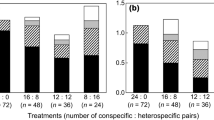Abstract
Sex ratio manipulation by ovipositing females was surveyed in 3 solitary ectoparastic wasp species,Dinarmus basalis (Pteromalidae),Anisopteromalus calanrae (Pteromalidae), andHeterospilus prosopidis (Braconidae), that parasitize azuki bean weevil (Callosobruchus chinensis (L) (Coleoptera: Buruchidae)) larvae within azuki beans (Vigna angularis). Variables were local mate competition (LMC) and host quality (HQ). We used host age as a measure of host quality (from 9-to 16-day-old hosts), changed the number of ovipositing females to control the level of local mate competition (1 female and 10 females), and examined oviposition patterns of the wasps. The offspring sex ratios (proportion of females) of the 3 wasp species respond qualitatively same to HQ and LMC. The common qualitative tendency among the 3 species is an increase of sex ratios increase with host age. In the process of changing the sex ratio (9–13-day-old) 3 wasp species respond only to HQ. In the hosts that end development in size (14–16-day-old) wasps respond to LMC. The response of sex ratio change to LMC in the old host ageclasses are different among the 3 species. In the situation that there exists LMC (10 females) sex ratios are the same among the 3 wasps. However, the sex ratios in no LMC (single female) are heterogeneous among the 3 wasps.
Similar content being viewed by others
References
Charnov, E.L. 1979 The genetical evolution of patterns of sexuality: Darwinian fitness.Am. Nat. 113: 465–480.
Charnov, E.L. 1982 The theory of sex allocation. Princeton University Press, New Jersey.
Charnov, E.L., R.L. Hartogh, W.T. Los-Den Jones & van den J. Assem, 1981 Sex ratio evolution in a variable environment.Nature 289:27–33.
Flanders, S.E. 1939 Environmental control of sex in hymenopterous insects.Ann. Entomol. Soc. Amer. 32:11–26.
Frank, S.A. 1985 Hierarchical selection theory and sex ratios II. On applying the theory, and a test with fig wasps.Evolution 39:949–964.
Frank, S.A. 1986 Hierarchical selection theory and sex ratios I. General solution for structured population.Theor. Popul. Biol. 29: 312–342.
Fujii, K. & Mar Wai Khim 1990 Sex-ratio determination in three wasp species ectoparasitic on bean weevil larvae. Bruchids and Legumes: Economics, Ecology and Coevolution, Kluwer Academic Publishers, pp. 331–340.
Hamilton, W.D. 1967 Extraordinary sex ratios.Science 156:477–488.
Hamilton, W.D. 1979 Wingless and fighting males in fig wasps and other insects. Reproductive Competition and Sexual Selection in Insects. New York, Academic Press.
Herre, E.A. 1985 Sex ratio adjustment in fig wasps.Science 228:896–897.
Holmes, H.B. 1972 Genetic evidence for fewer progeny and a higher percent males whenNasonia vitripennis oviposits in previously parasitized hosts.Entomophaga 17:79–88.
Ikawa, T., M. Shimada, H. Matsuda & H. Okabe 1993 Sex allocation of parasitic wasps: local mate competition, dispersal before mating and host quality variation.J. evol. Biol. 6: 79–94.
Karlin, S. & S. Lessard 1986 Theoretical studies on sex ratio evolution. Princeton, New Jersey, Princeton University Press.
King, B.H. 1987 Offspring sex ratios in parasitoid wasps.Quat. Rev. Biol. 62:367–396.
King, B.H. 1988 Sex-ratio manipulation in response to host size by the parasitoid waspSpalangia cameroni: A laboratory study.Evolution 42:1190–1198.
King, B.H. 1989 A test of local mate competition with a solitary species of parasitoid wasp,Spalagia cameroni OIKOS 54:50–54.
Moriguchi, Y. 1992 Host size dependent sex ratio control in the parasitoid wasp,A. nisopteromalus calandra. Dissertation, University of Tsukuba, Japan.
Nishimura, K. 1993 Oviposition strategy of the parasitic wasp Dinarmus basalis (Hymenoptera, Ptermalidae).Evol. Ecol. 7:199–206.
Stubblefield, J.W. &J. Seger 1990 Local mate competition with variable fecundity: dependence of offspring sex ratios on information utilization and mode of male production.Behav. Ecol. 1:68–80.
Suzuki, Y. & Y. Iwasa 1981 A sex ratio therapy of gregarious parasitoids.Res. Popul. Ecol. 22:366–382.
Sokal, R.S. & F.J. Rohlf 1981 Biometry. 2nd ed. Freeman. New York.
Taylor, P.D. & M.G. Bulmer 1980 Local mate competition and the sex ratio.J. theor. Biol. 86:409–419.
Werren, J.H. 1980 Sex ratio adaptations to local mate competition in a parasite wasp.Science 208:1157–1160.
Werren, J.H. 1983 Sex ratio evolution under local mate competition in a parasitic wasp.Evolution 37:116–124.
Werren, J.H. 1984 A model for sex ratio selection in parasitic wasp: local mate competition and host quality effects.Neth. J. Zool. 34:
Werren, J.H. 1987 Labile sex ratios in wasps and bees.BioScience 37:498–506.
Werren, J.H. & G. Simbolotti 1989 Combined effects of host quality and local mate competition on sex allocation inLariophagus distinguendus.Evol. Ecol. 3:203–213.
Wilkes, A. 1965 Sperm transfer and utilization by the arrhenotokous waspDahlbominus fuscipennis Zett.) (Hymenoptera: Eulophidae).Canad. Ent. 97:647–657.
Wylie, H.G. 1973 Control of egg fertilization byNasonia vitripennis (Hymenoptera: Pteromalidae) when laying on parasitized house fly pupae.Canad. Ent. 105:709–718.
Author information
Authors and Affiliations
About this article
Cite this article
Nishimura, K., Jahn, G.C. Sex allocation of three solitary ectoparasitic wasp species on bean weevil larvae: Sex ratio change with host quality and local mate competition. J. Ethol. 14, 27–33 (1996). https://doi.org/10.1007/BF02350089
Received:
Accepted:
Issue Date:
DOI: https://doi.org/10.1007/BF02350089





